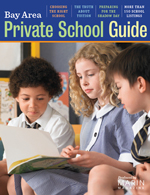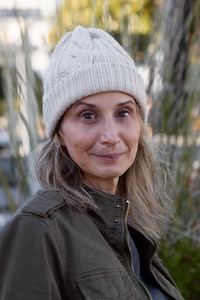Choosing a Private School
Curriculum, class size, cost are all factors to consider
When Lorin Costolo and her family moved from the Midwest to Marin last year, they enrolled their children in public school. “Our son adapted quickly. But our daughter’s transition didn’t go quite so well,” Costolo recalls. Although she and her husband had never considered private school in the past, they decided that if the public school wasn’t a good fit for their daughter, they ought at least to consider other options.
“I started asking around, trying to get a consensus about which was the best private school,” Costolo says. “It didn’t take long to realize that there wasn’t one best school. Every parent I spoke with had a list of reasons why they thought their child’s school was best. I began to realize that when it comes down to it, every child is different, so the perfect school for my daughter might not be the perfect school for someone else’s kid.”
According to local education experts, Costolo’s observations are spot on. So if that’s the case, how are parents supposed to find that one best place for their child?
For starters, if you’re even toying with the idea of private school, begin your research immediately. You’ll need time to tour all the prospects and have your child “shadow” (see story on page 16) at schools whose programs are most appealing. “It’s helpful to attend open houses or even do drive-bys so you can get a sense of a place,” suggests Stacie Grant, director of high school admissions at San Domenico School in San Anselmo. Likewise, you’ll want to ask school administrators for names of currently enrolled families you can contact for insight. Talking with other parents, you’re likely to get honest appraisals that are free of the requisite PR spin.
You’ll also want to carefully consider each school’s educational philosophy. Some schools, for example, emphasize project-based learning; some stress creative thinking or analytical reasoning. If your child has a specific learning style, teaching approach can make all the difference for academic success. Also, private schools aren’t legally restricted on how they handle religion, so you need to consider what if any role spirituality plays in a school’s day-to-day. “Our school community includes families of all faiths,” say Bryan Clement, principal for Saint Hilary School. “But parents should know that our curriculum does investigate morality and character development through the study of Catholic beliefs.” Likewise, Brandeis Hillel Day School welcomes students of any religious denomination, but the curriculum does include Judaic studies and Hebrew language.
Class size is another factor to keep on the radar. It stands to reason that the lower the staff-to-student ratio, the more individualized attention a child will receive. But for some kids, having only a dozen kids in class (or possibly even the whole grade level) can be socially stifling. Conversely, a shy child might thrive in a small class, but feel lost in a bigger sea of new faces.
Finally, be sure to give proper weight to your child’s opinions. “The shadow day helps us decide whether a child is a good fit in our school, but it’s just as important that the child walk away from the day feeling good about us,” says Donna Fanfelle, co-director of admissions for Marin Primary and Middle School.
Saint Hilary’s Bryan Clement concurs. “I usually ask to talk to the student without their parent in the room,” he says. “I want to know whether this is something that the child wants or something his parents want for him.” If it’s the latter, that “doesn’t mean that the school won’t work, but it’s something I need to know ahead of time.”
Of course, few experts would advocate giving a child the final say on a matter as important as education. But if you really want to find the right school for your child, your child’s voice needs to be heard.
Once you’ve gathered and sifted through all this information, choosing the right private school for your child won’t be quite so daunting. Not, at least, till it’s time to pull out the checkbook.
Preparing for the “Shadow Day”
Choosing the right private program is only half the battle. The second hurdle is getting the school to choose you. The school will base its admission decision on a number of factors, including teacher recommendations, tests scores and, sometimes, an application essay. However, administrators recognize that what looks like a good fit on paper might not be so ideal in real life. That’s why many schools require prospective pupils to come in for a “test” day at the school, commonly referred to as a shadow day. In addition, teens applying to high school will be asked in for an on-site interview. We asked private school education experts for their best advice on how to make sure these later steps in the application process go smoothly. Here’s what we learned:
1 Don’t coach your child to do or say certain things to impress the staff. A shadow day is not like a job interview. Transparency is key. If the teachers don’t get a true sense of the child’s disposition, they won’t know how the child will fare in the classroom. “We are not necessarily looking for the kid with the strongest academic record,” says Donna Fanfelle, admissions co-director for Marin Primary and Middle School in Larkspur. “Some of the greatest kids are somewhat complicated and have an uneven developmental profile. We just want to make sure the child’s personality will ‘mesh’ in the classroom.”
2 Your child will feel more comfortable if he blends in with the other students. And dressing the part will help. So if, for example, the school requires kids to wear a uniform, you should encourage your child to wear clothing of the same color.
3 For a timid child, the idea of spending an entire day with a roomful of strangers can be overwhelming. If you think a full day of “shadowing” may be too much for your child, talk to the admissions director about other options. “We understand that it’s a hard thing to do, so we’re flexible,” says Fanfelle. “If you think your child would do better coming for two half-days, we can work with you.”
4 Explain to your child that the main objective of the day is to observe and absorb. It’s important the child understand that no one expects that she have all the answers in class. The staff recognizes that different schools teach different curricular units at different times.
5 Make sure you allow at least a week between each school visit. Even for the most outgoing children, spending the day at an unfamiliar school can be stressful. If you schedule these visits too close together, your child may not always feel at the top of his game. Spacing them apart also helps make sure he doesn’t fall behind in studies at his current school.
The Special Needs Child
Dash Seerly has dyslexia and ADD, as well as some social cognition deficits. These learning issues made life in the public schools an absolute nightmare. “He was reading at a third-grade level in sixth grade, and being bullied constantly,” recalls his mother, Holly Seerly. “By
seventh grade his self-esteem was in tatters. He was so anxious that he stopped eating and lost 20 percent of his body weight. His doctors were going to hospitalize him, thinking he was anorexic,” she adds. “Before taking that step, I told his doctor I was going to try taking him out of school for a week and see what happened.”
Sure enough, Dash started eating again. Within a week, he’d gained three pounds. Though Seerly wasn’t in a financial position to afford private school, she came to the sobering realization that she could no longer afford not to send him. So she cashed in her retirement fund and enrolled her son at the Star Academy in San Rafael, a private school that offers intensive, individualized academic programs for students with multiple learning differences.
The maneuver proved life-changing. “Within a week of starting, he stopped complaining about having to go to school,” Seerly says. “He used to beg me to let him drop out or at least home-school him.” Over the next several years, Dash made considerable progress, both socially and academically. When he reached his junior year in high school, he felt ready to re-matriculate into the public school system.
The decision to put a child in a special-needs school isn’t always easy. For some, like Seerly, it’s a question of finances. For others, it’s about grieving and then accepting that a child has needs that can’t be met in a school for typically developing children. “Parents need to get to the point where they accept that their child may not have the same school experience as they had, and that that’s OK,” says Roberta Havens, admissions director and high school adviser for the Laurel School in San Francisco, which has a program allowing students with learning differences to work at their own pace. “A lot of our families need to circle the block a few times before they come to peace with the decision.”
So, finances and emotions aside, how do you know when to make the move? After all, the public schools are obligated by law to provide services for children with ADD and other learning issues. At what point do you conclude the programs at your school won’t cut it? A number of red flags might point the way.
Certainly, the most important consideration is your child’s self-esteem. “Children with learning differences figure out very quickly that they are different from their peers, and if they come to believe these differences mean they are stupid, it can have devastating effects,” Havens says. Of course, such kids may not come out and tell you they’re feeling inadequate; more than likely they’ll show it by acting out.
“They may become a behavior problem in the classroom, or simply make poor social choices in a misguided effort to fit in,” Havens says. Other children may develop physical symptoms such as headaches and stomachaches. If getting your child to go to school each day has become a monumental chore, it’s likely the program is just too taxing. Or, some kids “may hold it together fine at school, but after returning home they just plain lose it,” Havens notes. Another sign of trouble: standardized test scores that are totally out of sync with your child’s in-class performance. The child may do well in class, but bomb on the tests—or vice versa.
While looking into special-needs learning can require some soul-searching, if you do decide that’s best for your child, the benefits can be immeasurable. They were for Holly Seerly’s son, who graduated from Tam High this past June with a 3.8 grade point average. Her only regret: “I just wish I’d have switched him sooner.”
The Bay Area has numerous school choices for special needs children that deal with both learning and emotional issues. Listed below are several alternative schools in Marin County and San Francisco. To learn more about these schools visit their websites.
Allaire School | allaire-school.org, 415.927.2640.
1–8 grade, coed, learning disabilities, ADD, ADHD
Joshua Marie Cameron Academy | jmcacademy.us
415.642.1134. 12–19 years old, coed, LD, SLD, ED
Oak Hill School | theoakhillschool.org, 415.457.7601.
6–22 years old, coed, autism, learning disabilities
Sand Paths Academy | sandpathsacademy.org
415.826.2662. 6–12 grade, coed, LD, ED, ADHD
Star Academy | staracademy.org, 415.456.8727.
7–18 years old, coed, ADD, ADHD, dyslexia,
learning differences
Sterne School | sterneschool.org, 415.922.6081.
6–12 grade, coed, ADD, ADHD, dyslexia
The Laurel School | thelaurelschool.com, 415.752.3567.
K–8 grade, coed, ADD, ADHD, dyslexia
Timothy Murphy School | timothymurphyschool.org
415.499.7616. 7–18 years old, boys, SLD, SED
Sunny Hills Services | sunnyhillsservices.org
415.457.3200. K–12 grade, coed, serves students with severe
emotional and behavioral challenges
The Tuition Factor
Scholarships can help ease the financial burden
In today’s economic climate, a private school education may seem more out of reach than ever. But that’s not necessarily the case. Despite the stereotype of elitism and privilege, private school administrators have come to recognize the benefits of a diverse student body. That’s why nearly all Bay Area private schools offer scholarships as a way to attract pupils whose parents aren’t real estate moguls or Fortune 500 CEOs.
“Financial aid is a tool we use to build the strongest possible class,” says Phil Gutierrez, director of admission at the Branson School in Ross. “Each year about 20 percent of our students receive financial aid that typically covers around 70 percent of tuition costs.”
Just how much money is set aside for aid and exactly which candidates receive it can be a complicated equation. But to try and make sure they’re awarding the dollars on a logical and fair basis, schools strive to keep admissions separate from the aid process. “We try to keep the application process ‘need blind,’” says Donna Fanfelle, admissions director for Marin Primary and Middle School. “We accept the children first and then decide whether or not they qualify for financial aid.”
To make such funding as objective as possible, Marin Primary and many other Bay Area schools channel all requests for financial aid through a nonprofit called School & Student Services (SSS). The organization, which helps schools assess these requests, receives about 140,000 applications a year from 2,200 private schools. Families submit their financial particulars to SSS, filling out a form on its website with information similar to what you’d declare on a tax return. SSS then runs the data through its proprietary software system and sends a report to the schools where the family has applied.
If you were hoping to get a full ride, well, that’s a little harder to come by; most schools require families to pay at least some portion of the tuition themselves. But a number of local organizations do award additional scholarship money. “We are currently supporting 5,000 students at 300 Bay Area schools,” says Rachel Elginsmith, executive director of the Basic Fund, a privately funded program seeking to help low-income families afford the cost of Bay Area private schools.
Other scenarios exist: for example, some schools offer children of staff members a full or partial tuition break. If a job change for you isn’t realistic right now, you might offer professional services in exchange for a discount. And if you’ve been squirreling away a college fund, consider the fact that financial aid is easier to come by at the university level, and grants and scholarships more plentiful, so dipping into that kitty is at least worth a thought.
Purchase the 2010 Guide
| Get a copy of the 2010 Private School Guide –> |  |

Dawn Margolis Denberg has worked as a professional journalist for 20 years. Her work has appeared in top publications, including Wired, Shape and Parenting. She has also written several books for children including, The Men in Black Agent’s Manual The Official Godzilla Movie Fact Book. And, most recently, an episodic audio series for Tales Untold.


